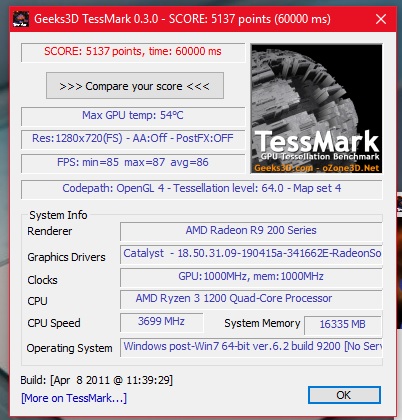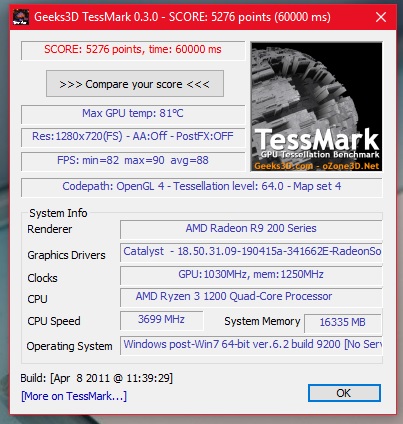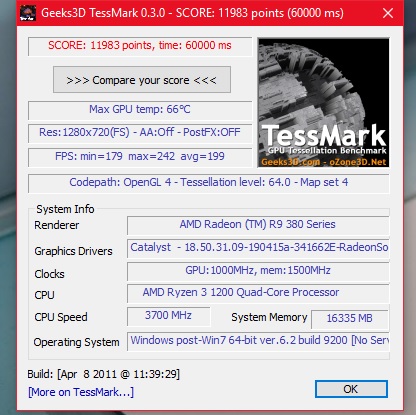GCN Geometry performance update, feat. Hawaii
- Sasha W.

- May 21, 2019
- 3 min read
Updated: May 26, 2019

I got a 290X to test Hawaii's geometry / tessellation performance, but this time only in TessMark and Unigine Heaven, because they are most taxing on the tessellators and geometry engines. The other games I tested in my original comparison would be apples to oranges since Hawaii also has twice the Render backend, and 12 more CU (768 shaders, 48 Texture units). It also has a much wider bus, at 512bits and apparently WattMan won't let me drop the memory clock rate below 5Gbps. So I cant match the other cards' bandwidth, not that it really matters anyway. Obviously in this games tessellation isn't the be-all and end-all of performance, so yeah. Anyway...
I ran TessMark and Unigine Heaven and my results really surprised me. Actually I'm pretty stumped. Also apparently Anandtech found the same thing with Hawaii. So unless you went and clicked that link I bet you are wondering what I mean. Okay, so with Hawaii AMD stated they literally doubled up on the Geometry engines, that means tessellators too. So I was expecting, you know, something near twice the throughput in these workloads. Except... that really doesn't happen. In fact Hawaii is barely faster than Tahiti, which as only two Geometry engines. So what gives? Anandtech writer does dive a bit into that in that article too.
Anyway, my results. TessMark, with all Five GCN revisions!: (oh, by the way, all my tests are conducted with Tessellation set to "Use Application Settings" in Radeon Driver. Otherwise AMD likes to put a cap on the max factor, to, you know, levels that don't make GPU cry with no visual gain ahem Crysis 2 ahem).

What. Okay so Hawaii's doubled engines give it almost no major gain over Tahiti. There is a slight, and measurable gain of 4.7%. Bit small given the 100% higher geometry pipelines. What gives? I have no idea.
Let's move on to Heaven, using these settings the engine is basically a synthetic test of Pure Unrelenting Tessellation Doom. I didn't test Vega 20 here yet but I might add that later. This is a custom bench run of the scene around the Dragon Statue in the courtyard, with all Tessellation factor and distance set to maximum, to really put a strain on those Geometry Engines.

Welp. This proves its geometry/tessellation limited. Because Hawaii has twice the ROPs of Tahiti (64 vs 32) and 37.5% more shading and texture power... and is only about 20% faster here. Some of that scene is benefiting from the increased shader and pixel muscle, but Hawaii is still hugely limited by its geometry and/or tessellation throughput. But more strange is the fact that the Tonga chip is driving over 90% more frames per second, with apparently the same number of geometry engines and core clock speed. I'd like to do a test without heavy tessellation, instead just really complex original meshes, to see if the gains are larger.
I don't even know what's going on with the tessellation performance here. But I retested it many times to verify the results and it's all the same. So at least...

Update: But not because I found out the "issue". It's actually an update to say I tried and retested this again and again with clean driver installs and closing all applications that were running (Something was actually causing the bench to stutter), and forcing 64X tessellation in the driver, using AMD optimised, etc, etc. And nothing changes. The 290X still scores barely better than the 280X. Here are the results for Tahiti, Hawaii and Tonga, respectively.
Oh, 290X is reported at 1030 MHz. I do not not know why the bench reported that. I definitely had it running at 1000 MHz core. Results do not change substantially over my previous results except for the lack of stutter, which increased the minimums and pushed the average on Tonga up a bit. I really want to know why Hawaii is showing almost no gains here.









Comments